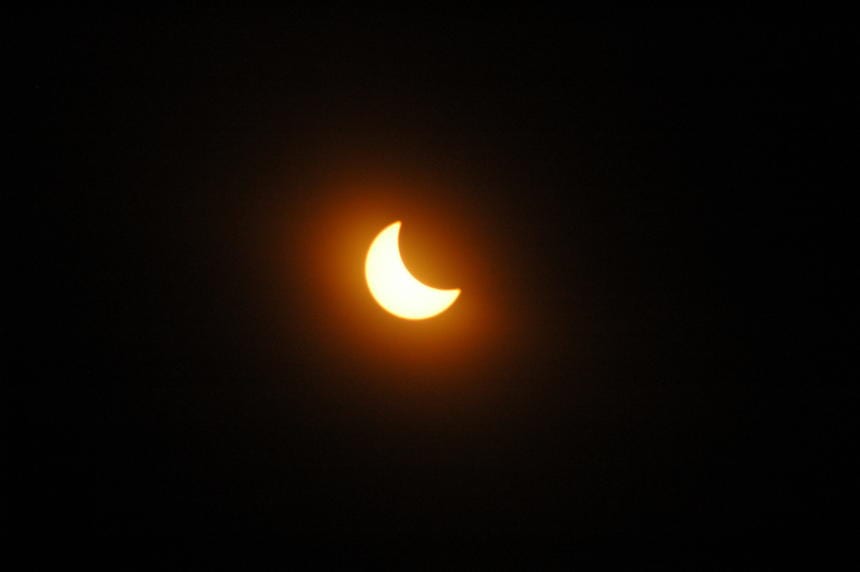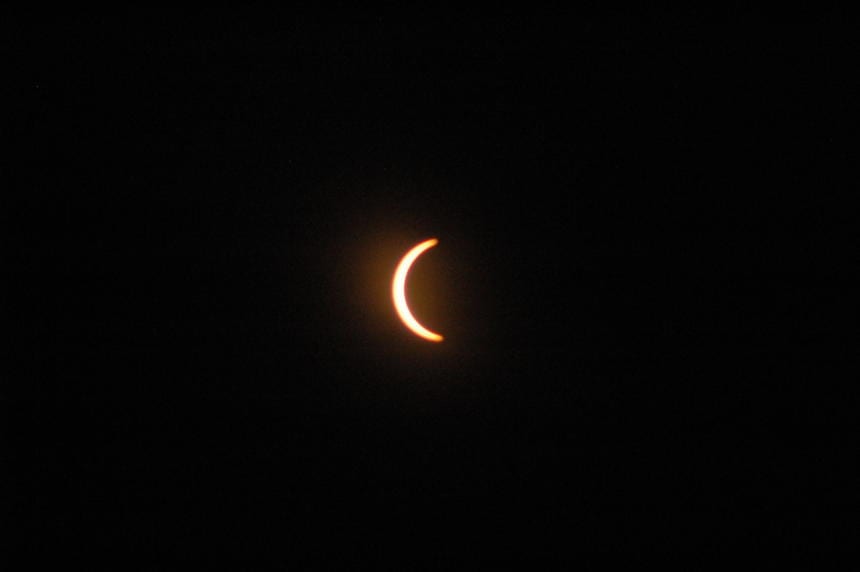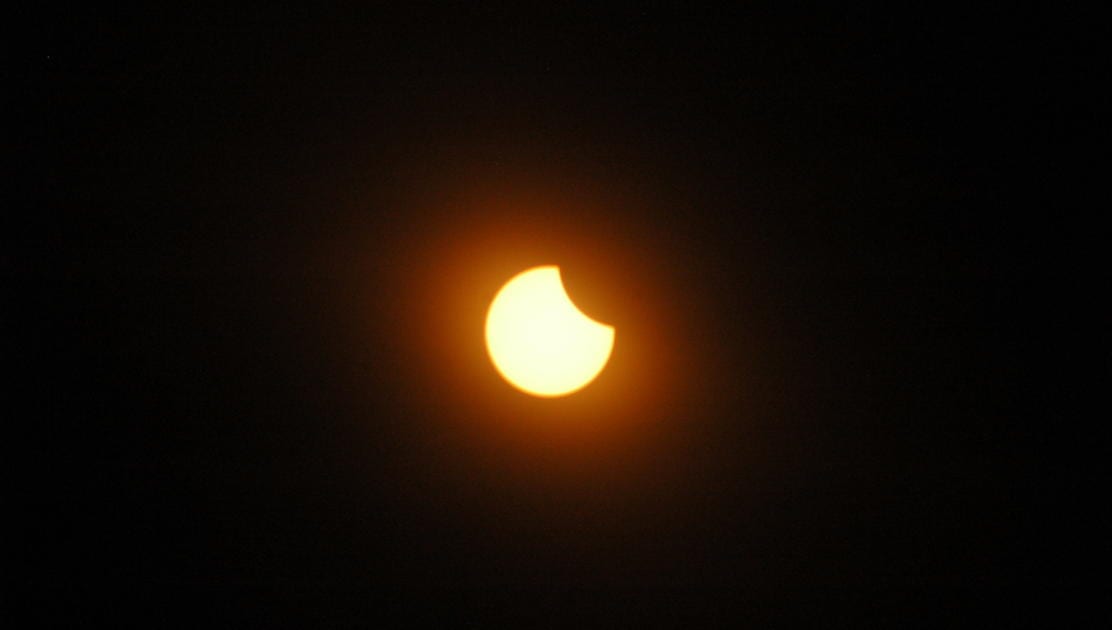Seen and Unseen
On the Joy and Disappointment of the Great American Eclipse
By Matt MilesFor weeks before the event, some friends and I started preparing for the the Great American Eclipse of 2017. There were 25 of us, all of whom would watch together from a hay field next to a vineyard. While not in the 70-mile wide path of totality, our location in northwestern North Carolina seemed close enough—in the 97% range—to get excited about viewing the event near home.
We all had different ways of preparing for the eclipse. Some of us read articles and viewed simulators, while others built pinhole cameras or pondered how animal life might respond to the strange and rapid loss of daylight. I’m an amateur photographer, so I decided to try my hand at documenting the various stages of the eclipse. What follows are my journal notes from August 21, 2017.
***
12:03 PM
Tasha, her father, and I drive the short distance from our farm to our friend’s vineyard and begin setting up a shade tent to escape the worst of the heat on a mostly cloudless but sweltering day. We unfold camp chairs and crack open cold beverages as other eclipse watchers arrive, setting up on the dry straw of the recently mown field.
As they get out of their cars, our hostess hands each guest a pair of cardboard and plastic eclipse glasses, the lenses opaque to all but the most direct sunlight. At her urging, we test them, turning our heads toward the sun. And there it is: A great orange globe surrounded by utter darkness.
I unpack a tripod and position my camera atop it, an older DSLR with a solar filter made from the same material as the glasses, attached to the end of a 300mm telephoto lens. Through this filtered lens, I see the same bright orange ball, glowing in the sky.
As the start of the eclipse in North Carolina approaches and I fiddle with the settings on my camera, it seems most other attendees are focused on their smart phones, showing photos and reading accounts from points west, where the eclipse has already begun. One friend is in contact with a relative in Casper, Wyoming, a city within the 100% totality path. That city is hosting a three-day festival culminating with the eclipse, and is currently overrun with tourists who have come from as far as Japan to see this “once-in-a-lifetime” event.
1:17 PM
I look up through my glasses and notice a tiny sliver of shadow forming over the top-right quadrant of the sun, and alert the rest of the group. I start to shoot photos, hoping the lens will work with the shutter speed and f-stop I have set. I can’t get the time delay to work, so I steady the camera on the tripod with my hand and try my best not to jerk the camera.
As the eclipse progresses, more and more of the sun is shaded out by the moon. After months of dire warnings from the media not to look directly at the sun, we are careful to observe the action only through the separation of our glasses. This makes the experience seem somehow simulated, disconnected from the real thing.

Photos taken by the author, Matt Miles
2:15 PM
The temperature drops noticeably and the scorching air now feels cooler. Through the eclipse glasses, one can plainly see the sun disappearing behind the moon. A peculiar kind of murky twilight settles over the field as the eclipse approaches its greatest extent, though I’ve seen it darker than this before thunderstorms. I see a group of what I think are bats, before realizing that they’re only birds, albeit noticeably confused by the receding daylight.
2:37 PM
The eclipse is as total as we will experience it. The sun, seen through glasses and the filtered lens of my camera, is a mere crescent—an orange sliver, resolving at the far left of the moon’s shadow and slowly shifting clockwise until it appears, eyebrow-like, above the moon. As the moon continues its transit away from the sun, the effect gradually dissipates and the sky grows brighter. The temperatures climb once again. It’s all over.
2:45 PM
Several guests pack up their lawn chairs and begin to leave. Rather than linger and discuss the event, they seem eager to get back to whatever activities they had put off to witness the spectacle. I sense that they are underwhelmed by the experience, as I realize I am. But we remain a while longer, happy to enjoy the continued company of our friends in the shade of the tent.
3:20 PM
We return home and I download the photos I’ve taken, the visible evidence of this fleeting astronomical phenomenon. I’m pleasantly surprised to find a few good ones, and I dutifully post them to Facebook.
7:30 PM
“Do you think people from an earlier time would have gotten more out of this?” Tasha asks, as we discuss the day’s events.
“No, I don’t think so,” I say. “What was there really to see, anyway?”
Our conversation continues for a few more minutes. But there’s not much more to say. Other than spending a Monday afternoon outdoors with our friends, the day was somewhat unremarkable. Just another day living in the Anthropocene, I think to myself.
***
It’s later now, and I’m reconsidering my response. As Clark Strand wrote, “eclipses make human beings thoughtful. And this is a very good time to reflect.” But the more I think about the experience, the more I want to understand the reason for my disappointment. The Great American Eclipse, like much else in American life, was so thoroughly hyped by the media in the weeks leading up to the event that anything less than the most dramatic heavenly display was sure to end in disappointment. Still, it’s hard to blame the media for overselling this one positive event in American life amidst so much recent anger, division, and distrust.
But it occurs to me that the eclipse, at least the way I experienced it, was essentially a mediated experience in another sense. While no right-thinking person would stare directly at the sun and risk losing their sight, the mass-produced eclipse glasses were a safe and convenient alternative, a rudimentary and harmless technology—but a mediating technology, nonetheless. Without the glasses, there isn’t much for the eye to see of the sun directly.
I am reminded of an essay by British artist and writer James Bridle, in which he describes a much-hyped laser light show that accompanied the opening of a London skyscraper in 2012. Viewers were urged to watch the show via a live video feed on Facebook, but thousands attended the opening in person anyway and were duly disappointed when not much happened. Yet, as Bridle recounts, “newspapers and news sites were filled with stories of the ‘dazzling’ show.” As it turned out, “The laser beams… were not meant for human eyes, but instead were perfectly calibrated for the long exposures of high-end cameras, the devices owned by newspaper snappers and professional photographers.”
More insidiously, I think of the world of virtual reality that has of lately been promoted as the next big thing. In actuality, it is just the latest iteration in a long line of technologies that separate our senses from their physical surroundings and mediate our consciousness. For the price of a virtual reality headset, one gains access to a more appealing sensory realm where the increasingly urgent realities of a failing physical environment can be ignored.

Many of our technologies act as virtual extensions of our nervous system and our sensory organs. They overwhelm us with information about the world at the cost of blinding us, making us insensate, to the physical world in which we actually do live. At worst, they separate us from the cosmos and from each other.
Despite the few moments when I noticed the quality of the air or the odd birds in the sky, my own experience of the eclipse was very much a separation from my senses as I focused on my camera, seeing through an artificial eye in an attempt to “capture” the experience.
***
D.H. Lawrence saw this world of disconnection evolving almost 100 years ago, and he spent much of his life and literary career fiercely rejecting it while also seeking an alternative to replace it. Before his death in 1930, Lawrence had traveled extensively and lived abroad in Mexico, the U.S., Sicily, Sri Lanka, Australia, and elsewhere. In these places, he had sought to reclaim through contact with local “primitive” cultures or their artifacts some sense of primal consciousness which had been lost to Western civilization and its modern cultures.
Known chiefly for novels like The Rainbow and Lady Chatterley’s Lover, Lawrence’s last and possibly most obscure work, Apocalypse, best summarizes his thoughts on the difference between modern and primitive consciousness. It is this mythopoeic consciousness of earlier cultures and the way they viewed the cosmos that Lawrence sought to reclaim, describing the power of myth as “an attempt to narrate a whole human experience, of which the purpose is too deep, going too deep in the blood and soul, for mental explanation or description.” In contrasting the mythical consciousness of the Chaldeans with the our modern rational and scientific consciousness Lawrence attests:
I would like to know the stars again as the Chaldeans knew them, two thousand years before Christ. I would like to be able to put my ego into the sun, and my personality into the moon, and my character into the planets, and live the life of the heavens, as the early Chaldeans did… Because our sun and our moon are only thought-forms to us, balls of gas, dead globes of extinct volcanoes, things we know but never feel by experience.
***
Perhaps it is this visceral longing Lawrence describes—to feel our place in the cosmos again—that accounts for some of the mania surrounding this eclipse. Perhaps our relation to the cosmos and our inter-relationship with the natural world has become so distorted through the artificial world of our media and technologies that we have become blind and deaf to the wonder and beauty surrounding us every day, understanding the sun only as a thought-form, a ball of gas. Perhaps the sun has become something that is only really visible to our modern consciousness, ironically enough, at the moment of its total eclipse.
I can only wonder at what I might have missed during those short minutes of total eclipse had I traveled a few hours south, to witness the sky grow dark and the stars appear in the sky for a few brief moments, to see the gas plumes radiating from the sun’s eclipsed corona. Maybe it’s a remarkable thing in itself that so many of us set aside our daily concerns to witness an exceedingly rare cosmic event. I don’t know.
I do know that I have felt my place in the cosmos before. It didn’t take a rare celestial event, months of media build-up, or any special technologies—I had only to lay on my back and stare in wonder at the brilliantly luminous night sky blazing above.
Matt Miles is a writer, poet, permaculturist, maker, and rock climber. His work has previously appeared in Dark Mountain. He lives in the Blue Ridge Mountains of North Carolina where he and Tasha Greer run the reLuxe Ranch, a whole systems farmstead.
Photos courtesy of Matt Miles
